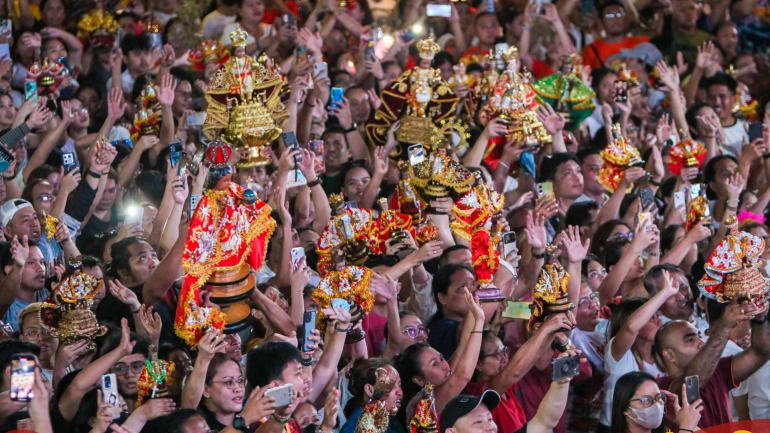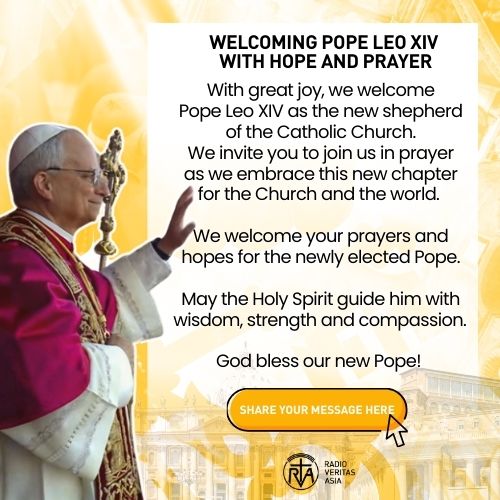Fiesta Señor 2025: A Pilgrimage of Hope Honoring the Sto. Niño de Cebu

“Every procession is a symbolic pilgrimage of hope,” says Ruben Labajo, first bishop of the newly created Diocese of Prosperidad in Agusan del Sur, Philippines.
Some two million devotees showed up across three separate foot processions and one fluvial parade in honor of the Sto. Niño de Cebu, Cebu City.
The event was scheduled across the nine-day novena (January 9–18, 2025) in honor of the Sto. Niño de Cebu; the Fiesta Señor, as the annual feast is known, is arguably the only religious feast that features multiple processions with a massive number of participants, mostly devotees and pilgrims across the Philippines and returning overseas Filipinos known as balikbayans.
The theme of this year’s Fiesta Señor was “Sto. Niño: Hope of the Pilgrim Church.”
Day 1 of the Fiesta Señor opened January 9 with a dawn procession titled, “Penitential Walk with Jesus.” Augustinian friars led the opening salvo, which started from the Cebu Capitol and ended in the Basilica del Santo Niño.
Devotees clutching images of the Sto. Niño and other religious icons prayed the rosary and sang religious songs along the procession route, covering a distance of 2.1 kilometers. According to police estimates, the throng of devotees peaked at 160,000.
Day 7 of the novena started with another foot procession, this time in honor of the Blessed Virgin Mary. Hundreds of thousands of Marian devotees showed up and prayed the rosary while holding images of the Virgin Mary and the Sto. Niño. Police estimated the crowd at 300,000.
On the eve of the Fiesta Señor (January 18, 2025), a fluvial parade was held along the Mactan Channel in honor of the Sto. Niño, Nuestra Senora Virgen de la Regla, and St. Joseph. The Holy Family images boarded the official vessel named “Sto. Niño, de Cebu” on its maiden voyage.
The galleon was escorted by hundreds of boats in a festive and colorful fluvial parade followed by thousands online.
Close to 10,000 devotees and onlookers gathered around Cebu City’s Pier 1 dancing to the beat of the Sinulog while waiting for the arrival of the galleon with the Sto. Niño is on board. After the fluvial parade, Fr. Andres Rivera Jr., OSA rector of the Basilica Minore del Sto. Niño de Cebu, celebrated Mass.
In the afternoon of the same day, devotees joined the solemn foot procession from the basilica, passing through four major city thoroughfares, a distance of 5.7 kilometers. It was scorching hot throughout the procession that started at 1:30 PM and ended around 4 PM when the Sto. Nino's image reached the Basilica.
The Cebu Risk Reduction and Management Office (CRRMO) reported that despite some minor hitches, the foot procession went well and orderly. The crowd peaked at 1.4 million, according to the CRRMO.
The solemn foot procession ended with a Eucharistic celebration in the Basilica with Cebu Auxiliary Bishop Ruben Labajo officiating.
In his homily, the prelate, recently appointed by Pope Francis to head the newly created Diocese of Prosperidad in Agusan del Sur, shared his reflections on procession, a religious worship that dates back to the colonial days of the Catholic church in the Philippines.
“The traditional practice of procession in the Catholic perspective is a symbolic forward movement that characterizes our nature as a pilgrim church,” said Bishop Labajo.
It has a sacred goal that entails patience and perseverance in the hope of reaching the destination in time and ultimately in heaven, he added.
"Every procession is a symbolic pilgrimage of hope. We march forward believing that God accompanies us to reach our destination, believing that he never disappoints us,” Labajo said.
He shared a historical clip to show that honoring the Santo Nino in religious processions is not a modern-day tradition. Rather, it began in the 16th century when the Spanish conquistadores led by Miguel Lopez de Legaspi arrived in Cebu.
After the local chieftains in the neighboring island of Bohol pledged their support for the Spanish invaders, Legaspi set foot in Sugbu (the old name of Cebu) on April 28, 1565, with great enthusiasm.
It was also learned that the Spaniards in Sugbu discovered and took possession of the image of the Holy Child in a settlement previously occupied by the Sugbuanons.
Augustinian friars settled in the village after the Sugbuanons abandoned it, and it was there that they discovered the Sto. Nino icon.
Tension rose because the natives believed the religious image was the same icon gifted by Spanish explorers to local chieftain Rajah Humabon and his wife Queen Juana in 1521. The Sugbuanons wanted to claim the icon; however, Legaspi didn’t budge and instead took the image to the galleon, which was docked ashore away from the frustrated villagers.
With patience and prayers, Legaspi was able to reach an agreement with the recalcitrant Sugbuanons.
Weeks after the peaceful resolution, it is said that Legaspi took the icon of the Holy Child from the galleon and, together with the natives, returned the icon to a house in the settlement where it was found.
On June 4, 1565, the peace between the Spaniards and Sugbuanons was formalized as per royal instructions from Spain, and the house where the icon was enthroned became the seat of the Augustinian Order.
Bishop Labajo said that the Sto. Niño was not only an important icon for the Spaniards and the natives but also a symbol of hope.
“Legaspi anchored his perseverance on divine hope,” he said. On the other hand, “the natives also anchored their new lives on divine hope.”
Bishop Labajo advised Catholics to base their requests for God's favors on Divine hope.
“First, believe in the Word of God. Pray and act in pursuit of the thing that you’re asking for. Be patient. Don't expect to receive it immediately. Believe, act, pray, and persevere,” he emphasized in Cebuano.
Concelebrating with Bishop Labajo were Cebu Archbishop Jose Palma, Bishop Patrick Buson of the Diocese of Bacolod, and Auxiliary Bishop Emeritus of Cebu, Antonio Ranola.
Friars belonging to the Order of St. Augustine led by Vicar General Fr. Joseph Farrel, Fr. Andres Rivera Jr., OSA, rector of the Basilica Minore del Sto. Niño de Cebu, and Fr. Andrew Batayola, Prior Provincial of the Augustinian Province of the Sto. Niño de Cebu, Philippines, were present with several diocesan priests and visiting priests from other congregations.
Following the Eucharistic celebration, Bishop Labajo and his co-celebrants, danced the traditional Sinulog.
Radio Veritas Asia (RVA), a media platform of the Catholic Church, aims to share Christ. RVA started in 1969 as a continental Catholic radio station to serve Asian countries in their respective local language, thus earning the tag “the Voice of Asian Christianity.” Responding to the emerging context, RVA embraced media platforms to connect with the global Asian audience via its 21 language websites and various social media platforms.
















